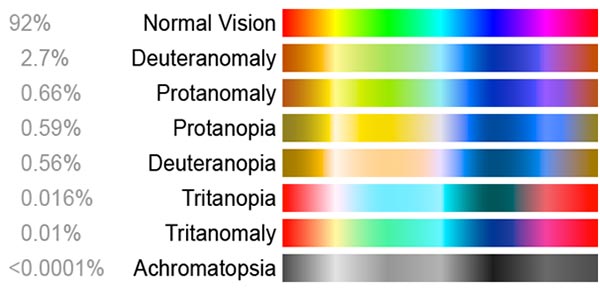Understanding colour blindness
Despite the name, colour blindness is not actually a form of blindness. Rather it’s the difficulty telling the difference between certain colours and shades. In fact, the correct term is colour vision deficiency. People with this condition are likely to see a group of colours all appear as the same hue.
Rods and cones
Our retina contains cells called rods and cones that respond to light and help us perceive colour. The cones are divided into 3 key types – short (S), middle (M) and long (L) wavelength. Colour blindness occurs when these cones don’t respond properly to variations in the wavelength, therefore altering the way we see colour.
A mild colour deficiency, when one or more of the cones are weak or faulty, results in conditions called Protanomaly or Deuteranomaly. A severe colour deficiency occurs when a type of cone is missing completely, resulting in Protanopia and Deuteranopia.
Let’s take a look into each of these in more detail:
- Protanomaly is a reduced sensitivity to red light. You’ll likely confuse shades of the same colour from the red-green-yellow spectrum.
- Protanopia means you’d be likely to confuse reds, yellows and greens, with red also appearing darker than usual.
- Deuteranomaly is a reduced sensitivity to green light. Like Protanomaly, you’re likely to confuse shades of the same colour from the red-green-yellow spectrum.
- Deuteranopia is similar to Protanopia whereby you’re likely to confuse reds, yellows and greens. The hue tends to shift towards the red end of the spectrum.
Red-green deficiencies
People with this deficiency confuse colours in the red-green spectrum. It is the most common type of colour blindness and while it is said to affect 1 in 12 men, it only occurs in 1 in 200 women. This might seem like a shocking statistic, but it all stems back to genetics.
Genes for the red and green colour receptors are found in the X chromosome, which of course females have two of, whilst males only have one. For women to be affected, both chromosomes would need to be defective.

This type of colour deficiency is much rarer, occurring in less than 1 in 10,000 people. Unlike their red-green counterparts, this form is not associated with the sex chromosomes.
People suffering with this condition are likely to experience difficulty telling the difference between greens and blues, due to a deficiency in the S-cones.
Tritanopia is the lack of blue cone cells. This causes blues to be confused with greys, oranges with reds and dark purples with black.

How is colour blindness diagnosed?
Most people realise that they have a colour vision deficiency naturally, after being unable to identify certain colours correctly. The most common way to test for colour blindness is using a series of Ishihara Colour Vision charts, developed by Japanese ophthalmologist Shinobu Ishihara.
The full test features 38 pages with circular ‘plates’ that contain dots of varying colours, intensity and sizes. They’re arranged in a way so that people fortunate enough to have normal colour vision will easily spot a single or two-digit number amidst the dots. Someone with colour blindness, however, would find this far more difficult, if not impossible.
Is there a cure?

Unfortunately, it is not currently possible to replace or repair cells in your retina and so there is no known cure for colour blindness. There are, however, wearables such as ‘Oxy-Iso’ glasses that are designed to help you distinguish colours more easily by enhancing the contrast between certain colours. If you have a red-green deficiency, they’d be able to help you pass the Ishihara test.
Living with colour blindness can be difficult in various aspects of life and jobs such as an army pilot require excellent colour perception, but many people manage and it’s not always a disadvantage. Some people with this deficiency are said to be better at detecting camouflaged insects and patterns, which we think is quite cool.
We’ve partnered with Colour Blind Awareness so that you can see the world, from Brazil to the Netherlands, through the eyes of people affected by this condition. You can view our interactive experience here.



